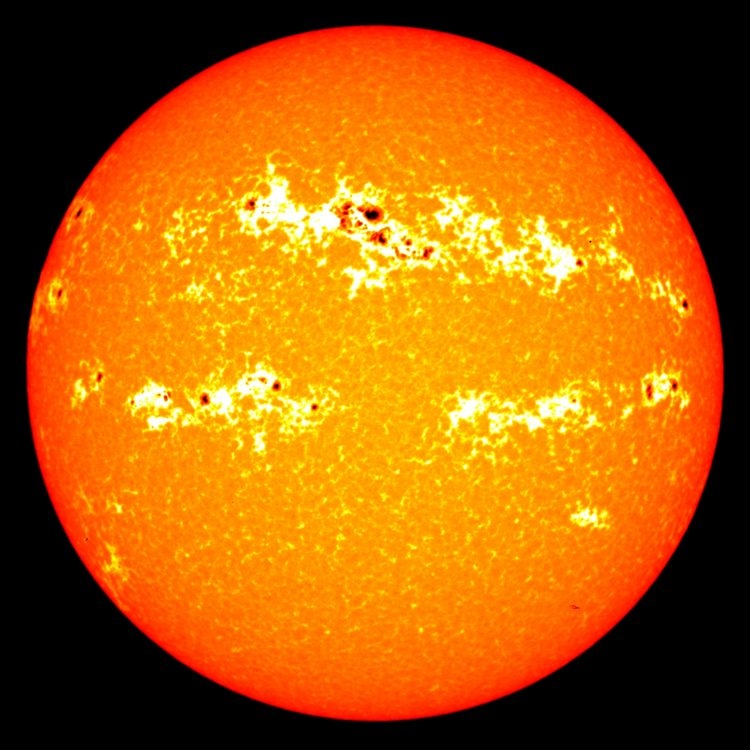Sep 20 2019
Sunspots are dark patches that appear on the surface of the sun and can be seen for weeks at a time. Although people have tracked these sunspots for 400 years, they have not been able to elucidate why the number of sunspots always peaks every 11 years.
 Sunspots can be seen in this image of solar radiation. Each sunspot typically lasts a few days to a few months, and the total number peaks every 11 years. The darker spots accompany bright white blotches, called faculae, which increase overall solar radiation. (Image credit: NASA/Goddard/SORCE)
Sunspots can be seen in this image of solar radiation. Each sunspot typically lasts a few days to a few months, and the total number peaks every 11 years. The darker spots accompany bright white blotches, called faculae, which increase overall solar radiation. (Image credit: NASA/Goddard/SORCE)
Now, a study conducted by the University of Washington (UW) suggests a plasma motion model that may shed light on this 11-year sunspot cycle as well as a number of other formerly mystifying characteristics of the sun. The study was recently published in the journal Physics of Plasmas.
Our model is completely different from a normal picture of the sun. I really think we’re the first people that are telling you the nature and source of solar magnetic phenomena—how the sun works.
Thomas Jarboe, Study First Author and Professor, William E. Boeing Department of Aeronautics and Astronautics, University of Washington
The researchers developed a new model that was based on their earlier work with fusion energy research. This model reveals that a thin layer present beneath the surface of the sun is crucial to the majority of the features observed from Earth—for instance, sunspots, solar flow, and magnetic reversals. This thin layer is backed up by comparisons with the sun’s observations.
“The observational data are key to confirming our picture of how the sun functions,” Jarboe added.
In the latest model, free-floating electrons, or a thin layer of plasma and magnetic flux, are observed to travel at a different pace on different parts of the sun. The variation in speed between the flows produces twists of magnetism, called magnetic helicity. This is akin to what occurs in certain fusion reactor concepts.
“Every 11 years, the sun grows this layer until it’s too big to be stable, and then it sloughs off,” Jarboe stated. When this layer departs, it reveals the plasma’s lower layer traveling in the opposite direction with a twisted magnetic field.
More sunspots appear when the circuits in both hemispheres travel at the same space. However, when the circuits are moving at a different pace, less sunspot activity is observed. According to Jarboe, that disparity could have occurred during many years of insignificant sunspot activity called the “Maunder Minimum.”
If the two hemispheres rotate at different speeds, then the sunspots near the equator won’t match up, and the whole thing will die.
Thomas Jarboe, Study First Author and Professor, William E. Boeing Department of Aeronautics and Astronautics, University of Washington
“Scientists had thought that a sunspot was generated down at 30 percent of the depth of the sun, and then came up in a twisted rope of plasma that pops out,” Jarboe added.
Instead, Jarboe’s model reveals that the sunspots occur in the “supergranules” formed within the plasma’s thin, subsurface layer. The study calculated these supergranules to be approximately 100 to 300 miles (150 to 450 km) thick, or just a fraction of the 430,000-mile radius of the sun.
“The sunspot is an amazing thing. There’s nothing there, and then all of a sudden, you see it in a flash,” Jarboe added.
Previous research performed by the team was focused on fusion power reactors, which utilize extremely high temperatures to isolate hydrogen nuclei from their electrons. These high temperatures are similar to those present within the sun. In the fusion reactors as well as the sun, the nuclei of two hydrogen atoms release large amounts of energy after fusing together.
Spheromak—the type of reactor considered by Jarboe—restricts the electron plasma inside a sphere that allows it to self-organize into specific patterns. Jarboe observed these similarities when he started to consider the sun and eventually developed a model for what might be occurring in the heavenly body.
“For 100 years people have been researching this,” Jarboe added. “Many of the features we’re seeing are below the resolution of the models, so we can only find them in calculations.”
Jarboe further informed that the theory explained other characteristics such as flow within the sun, the entire magnetic structure of the sun, and the twisting action leading to sunspots. He added that the study may trigger an intense debate.
My hope is that scientists will look at their data in a new light, and the researchers who worked their whole lives to gather that data will have a new tool to understand what it all means.
Thomas Jarboe, Study First Author and Professor, William E. Boeing Department of Aeronautics and Astronautics, University of Washington
The U.S. Department of Energy funded this study. Co-authors of the study are UW graduate students Thomas Benedett, Christopher Everson, Christopher Hansen, Derek Sutherland, and James Penna; UW postdoctoral researchers Aaron Hossack and John Benjamin O’Bryan; UW affiliate faculty member Brian Nelson; and Kyle Morgan, a former UW graduate student now at CTFusion in Seattle.